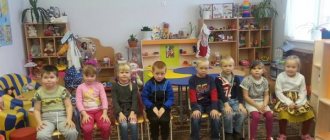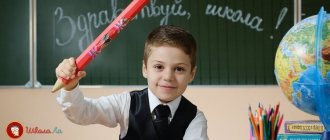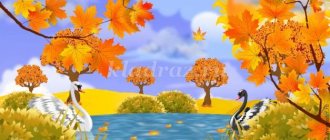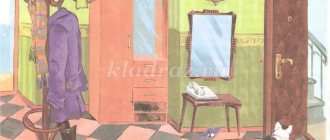Lesson notes for the senior group. My little homeland
Abstract of the GCD on the topic “My small Motherland” for children of senior preschool age
Description. The summary was developed for children of senior preschool age in order to expand knowledge of patriotic education. Goal: To develop the concept of “Small Motherland” in children of senior preschool age. Objectives: - Introduce the map and symbols of the Perm region. — Form ideas about the small Motherland, clarify and expand knowledge about your native village. — Teach children to agree adjectives with nouns, select antonyms. — Develop coherent speech, activate vocabulary on the topic. — Foster love and respect for the native land. Materials and equipment: Photographs, pictures for children “My small homeland – Kurashim”, “city of Perm”; geographical map of the Perm region; cards with the encrypted word Perm; game "Collect the coat of arms of Perm." Vocabulary work: Coat of arms, small Motherland, sights.
Progress of the lesson
1. Organizational moment The song “Where does the Motherland begin?” is played. Educator: - What is the song about? (About the Motherland) Educator: - Today we will talk about our Motherland. 2. Main part. Conversation about the Motherland Educator: - Tell me, what is the Motherland? Children: Homeland is the country in which we were born and live. These are forests, fields, rivers. This is our village. This is the place where loved ones live: mom, dad, grandpa, grandma. This is the place where our kindergarten is located. This is a place that people miss when they are in a distant land. This is the most precious thing a person has. This is the land where our ancestors worked. Educator: - Yes, each of you answered my question correctly. - Homeland is the country in which we live. - What is it called? (Russia) Educator: This is a map of our region. What is the name of the region in which we live? Children: Perm region.
Educator: (shows a map of the Perm region)
- We see that the Perm region is very large.
From one end to the other you need to travel by train or bus. There are many cities, towns, villages, rivers, lakes, forests in our region. Educator: What cities of the Perm Territory do you know? Children: Osa, Chusovoy, Dobryanka, Ocher, Okhansk, Kungur, Lysva, Vereshchagino, Nytva, Berezniki, Gubakha, Tchaikovsky, etc. — There are 25 cities in total. What is the name of the main city of the Perm region? (Perm) Educator: Guys, do you know that every region and every city in our country has its own symbols? Which? Children: Coat of arms, flag, anthem. Educator: The first symbol is the coat of arms of the city of Perm. - What is depicted on it? (Bear)
- Why do you think the bear? — The bear is the most revered animal of the ancient people. — There are many tales and songs about him.
Educator: - The bear is a symbol of natural resources, endless lands, where there are a lot of “metals”, multi-colored marbles and other stones and forests in which there are a large number of different kinds of wild animals. — The silver cross is a symbol of the sun; it means protection, victory, patronage. Educator: The second symbol of the city of Perm is the flag . The flag of Perm is a rectangular panel divided by a white cross into four rectangles of different sizes. In the center of the white cross is an image of the coat of arms of the Perm region. The colors of the flag of the Perm Territory simultaneously repeat the colors of the flag of the Russian Federation. - What flowers do you see? (children's answers)
White is a symbol of purity, goodness, peace. Blue is a symbol of the beauty of the water expanses of the Kama River, rivers and lakes of the Perm region. Red is a symbol of bravery and courage of the inhabitants of the Perm region. — What do the colors of the Russian state flag mean? Children: - White color - means peace and purity. Blue color - sky and fidelity. Red – fire and courage. Educator: - The third symbol is the anthem. — Maybe some of you know what the anthem is? Children: - The anthem is a solemn song. — In what cases do you think it is performed? Children: It is performed on especially solemn occasions: - during the raising of the state flag, - during national holidays, holidays for Victory Day, - during military rituals, sports competitions. When the anthem of any country is played, people who listened to it stand up, men take off their hats. This is how respect for the country is shown. Educator: In our city of Perm, the music of the anthem was written by Igor Mashukov. I invite you to listen to it (the anthem of Perm is played)
We are proud of our Perm region and our main city.
But each of us has a small Motherland - that corner of the earth where we were born, where our home is located. (The teacher shows the village of Kurashim on the map of the Perm region)
Please listen to the poem “Motherland”
(To the accompaniment of gentle calm music, the teacher reads
the poem “Motherland” by V. Stepanov ) What do we call the Motherland?
The house where you and I grow up, And the birches along the road along which we walk. What do we call Motherland? The sun is in the blue sky, And fragrant golden Bread at the festive table. What do we call Motherland? The land where you and I live! Educator: Our village of Kurashim is located in the very heart of the Perm region. Guys, how old are you? (children's answers)
How old is your mother?
Dad? Grandma? Grandfather? All people are of different ages. Do you think cities and villages have an age? Or are they all the same age? How old do you think our Kurashim is? (Children's answers)
Our Kurashim is already more than 300 years old.
Our village is already very old. This is what it looked like when I was young. (show photo) Educator: In our village there are two beautiful ponds (show photo of ponds)
a river flows into one of them, what is it called?
Kurashimka. (show photo)
Please name what streets are there in our village?
(Children's answers)
.
What are the sights? (children's answers) (showing photos)
.
Educator: - So the journey through our small Motherland has come to an end. Today you learned a lot about the Motherland. Is it true? Summary of the lesson (I post a model of the Motherland on a flannelgraph) Educator: Children, let’s summarize. We live with you in the big country of Russia. (green large circle)
In Russia there is our native Perm region.
(yellow circle of medium size)
And in the Perm region - our Kurashim.
(red small circle)
In the village of Kurashim is your home, your family.
(picture of a house)
.
— What would you like to wish for your country, your region, your village? Children: - So that there will always be peace in the world. - So that a bright, bright sun shines in the sky. - I want everyone to be kind. - So that every child has his own family. Relaxation There are emoticons on the table. You need to think about whether you liked the lesson, whether each of you was active in the lesson, what worked and what didn’t? Take a smiley face.
We recommend watching:
Notes on educational activities in the senior group “Northern Adventures” Notes on educational activities in speech therapy for the older group Notes on leisure activities in the senior group of kindergarten “What is kindness?” Lesson notes “The Mysterious World of Insects.” Senior group
Similar articles:
Lesson summary for older preschoolers on the topic: Transport
Developmental lesson in the senior group of preschool educational institutions
Drawing lesson for senior group
Summary of educational activities in the senior speech therapy group on the topic “Construction”
Summary of joint activities of the teacher and children of the senior speech therapy group on the development of fine motor skills of the hands
My little homeland. Summary of integrated educational activities
Topic: “My small Motherland”
Abstract
integrated educational activities
on the topic: “My small Motherland”
Prepared by: senior group teacher Margieva Dinara Dilyaverovna
TO
overview of direct educational activities
Topic: “My small Motherland”
Goal: to develop feelings of patriotism and love for one’s Motherland.
During the lesson, tasks are implemented in the following educational areas: Educational areas “Cognitive development” and “Socio-communicative development”
- introduce children to the concepts of: family, clan, relatives, large and small Motherland;
— enrich children’s knowledge about their small homeland - the Republic of Crimea; - develop an emotional and value-based attitude towards the natural environment and attractions of the native land. — to cultivate in children a love for the big and small Motherland and a desire to enhance the natural, cultural and historical heritage. Educational area “Speech development”
- strengthen children’s skills to correctly correlate a noun with an adjective: big and small Motherland, native country, native Crimea, favorite village;
dear mother, close relatives; gentle sea, basking country, ripe grapes, bunches of grapes, grapevine, sweet raisins. — teach children to expressively narrate the works of Crimean and Russian children’s poets. Educational area “Artistic and aesthetic development” -
strengthen children’s skills in drawing a bunch of grapes with their fingers
Educational area “Physical development” –
develop fine motor skills, motor activity of children through finger and folk games; develop physical qualities, coordination, flexibility.
Methods and techniques
: - visual: map of Crimea, illustrations of grape varieties, dummies of grape bunches; - verbal: conversation, literary word, story of a legend; — practical: tasting juices, raisins; finger painting; individual work to consolidate the pronunciation of words from an active dictionary, expressive reading of poems using facial expressions and gestures.
Preliminary work:
conversation about Russia, Crimea. Reading proverbs and sayings, poems, legends about the Motherland, about Crimea, looking at photographs of the sights of the native land, excursions around the native village.
Material:
audio recording of the children's song “Our Land” lyrics. Prisheltsa A., composer Kabalevsky D.; poster Crimea, bunches of grapes, illustrations using ICT.
Progress:
The teacher reads a poem:
There are many mothers in the world, Children love them with all their souls, There is only one mother, She is dearer to me than anyone else!
Who is she? I will answer: My dear mother! Question
: What kind of mommy?
- Dear! Let's repeat gently and affectionately: - dear mother_ How do you understand the meaning of the word dear? Children's answers. Educator:
Native means dear, close, beloved, sweetheart.
Question: Who or what else can we call family? Answers
: dad, brother, sister, uncle, home, kindergarten, country, city, region.
Generalization: A place where everything near and dear can be called your homeland in another way. Educator:
Each of us has a big Motherland and a small Motherland. The Big Motherland is our big country. What is it called? (Russia).
Play audio recording “My Motherland”
Educator
. That's right - we are part of Russia, this is our big Motherland. But everyone also has their own small homeland. Diana, Nastya and Karina know poems about their small Motherland, let's listen to them. Poem: Small Motherland is an island of land. Under the window, the currants and cherries blossomed. There is a curly apple tree, and under it there is a bench. My affectionate little Motherland! Motherland is a big, big word! Let there be no miracles in the world, If you say this word with your soul, It is deeper than the seas, higher than the skies! It fits exactly half the world: Mom and Dad, neighbors, friends. Dear city, dear apartment, Grandmother, kindergarten, kitten and me! (Tatiana Bokova)
Educator
.
How did you understand what a small homeland is? Children. I think that the small Motherland is the house in which I live, these are my parents, the village, the city. Educator. Guys, where is your little homeland? Children
. My little homeland is here, in Shkolnoe. Our village is in Crimea. A small country basks in the palms of the gentle sea, The mountains protect its sleep, The wave sings a lullaby... Crimea is a health resort and a miracle garden. Crimea is fruit, it is sweet grapes. Crimea is the sea, it is a paradise. Crimea is a steep southern mountain. Crimea is steppes and protected forests. Crimea is a fairy tale that looks into your eyes. So, guys, I want to tell you one such fairy tale: Let us try to travel to the distant, distant past, when people had not yet appeared on earth. A strong earthquake occurred and the earth's land rose from the sea waters. This is how our Crimea appeared. The wind and birds brought seeds of various plants to the Crimean land. Among them are grapes. But the grapes are wild, with small, black and sour berries. Birds and animals eagerly feasted on wild grapes. But then people appeared. Gradually they learned a lot: to build houses, grow plants. And then they paid attention to the wild grapes. They began to choose larger and sweeter ones. Over time, cultivated grapes were developed from wild grapes. Until now, scientists are developing new varieties of grapes: there are seedless grapes, with round, oval berries and many, many other varieties. Now think and tell me, who is a winegrower? This is a person who grows grapes. A piece of land on which grapes grow is called a “vineyard.” Our Crimean land is very suitable for growing grapes. If you drive along our peninsula, you will see many vineyards. There are many different varieties of grapes. Today we have three varieties: “Muscat”, “Isabella” and “Rkatsiteli”. Now it’s late autumn and we won’t be able to try them. When something is tasted to determine the taste or smell, it is called tasting. But now we will have a tasting of grape juice.
Juice tasting
Berries grown together, side by side, are called a bunch of grapes. An ancient legend tells where grape brushes of different colors came from. You and I have already read legends, and we know that this is a fairy-tale story about something that actually exists.
The Legend of the Grapes
“Grapes appeared on Earth a very, very long time ago. His mother was the Earth, his father was the Sun. At the time of the birth of grapes, their clusters did not take a month or two to ripen, as now, but quickly - from the day before dusk (evening), and those that managed to ripen by dawn borrowed its gentle blush from the morning dawn and turned pink. The grapes, ripened during the day, became golden yellow - they took over the gold of its rays from the sun shining brightly in the sky. The southern night imparted its dark or velvety blue tones to the berries that ripened late in the evening.” Nowadays, grapes ripen for several months: the first ripens in mid-summer, and the last, late grapes are harvested in mid-autumn. But the earth and the sun are still the parents of grapes. Without the sun, neither a grain nor a berry can ripen. The earth provides nutrition to the roots of the grape bush. But the stem and branches of a grape bush are called “vine”. Repeat this word and try to remember. The vine is flexible, long and thin. To prevent it from breaking due to the weight of the grape clusters, winegrowers tie the vine to a post. Birds, insects, and animals love grapes just as much as humans. Bees, wasps, and ants love to eat grapes. Hamsters hide grape berries in their cheeks and carry them into their underground storage room. And sparrows, rooks, and crows peck sweet berries directly from the vine. Let's play the outdoor game "Birds and Grapes."
Dynamic poise “Birds and Grapes”
Children pretend to run (“fly”) as birds. The leader (“watchman”), on the command “The watchman is coming,” begins to catch the “bird” children. At all times, people have valued grapes. In the old days, when wars raged on our peninsula, the victors dug up grapevines and took them home. After all, grapes provide not only delicious berries. Juice and wine are made from grapes. And also a delicious treat. Here it is. (Showing raisins). Do you know what this is? These are raisins - dried grape berries. For raisins, choose seedless grapes. Let's have a raisin tasting.
Raisin tasting
It turns out that grapes can still cure some diseases. And it also cleanses the human body, giving it strength and health. Let's draw a bunch of grapes. But first, let's prepare our fingers for work. These are the ones we will draw with.
Finger gymnastics “Grapes”
The index finger is the most inquisitive. He can press buttons, he can pick holes. And it depends on the owner how to use the craftsman. We'll train our finger and he'll draw grapes. Children clench their right hand into a fist, extend their index finger, press it onto the palm of their left hand and make rotational movements in one direction and the other. Then the same is done with the left hand.
Drawing “Bunches of Grapes”
Play the audio recording “My Motherland Without Words”
Children draw grapes with their fingers on a sheet of paper with a leaf, tendril and twig drawn on it. The teacher draws the children's attention to the fact that you can achieve different sizes of berries by changing the pressure of your finger. You can invite children to choose the color of their grapes. Pay attention to the shape of the thunderstorm: there are more berries on top, the lower, the fewer berries.
Questions:
1. How do cultivated grapes differ from wild grapes? 2. Who are winegrowers? 3. What is the trunk of a grape bush called? 4. What color are grape berries? 5. Retell the legend about the grapes. 6. What is made from grapes? 7. What are raisins called? 8. Who, besides man, loves grapes? By the way! Have you noticed that our Crimea is shaped like a bunch of grapes? Crimea is our Motherland, remember this! Do not spare your soul for her sake, Let the peaceful, kind sun rise over this green island!
State flag of the Republic of Buryatia
The state flag of the Republic of Buryatia is a rectangular panel consisting of three horizontally located colored stripes: the upper blue, making up two quarters of the width, the middle white, making up one fourth of the width and the lower yellow, making up one fourth of the width of the flag. In the upper left corner of the blue part of the flag, at a distance of one quarter of the length of the flag from the staff, the traditional symbol of Buryatia (soyombo) is depicted in yellow, which is an image of the moon, sun and hearth in the following sequence: below is the crescent of the moon, above it is the circle of the sun, and above them image of a hearth of three flames. The ratio of the flag's width to its length is 1:2
State emblem of the Republic of Buryatia
The coat of arms of the Republic of Buryatia is a heraldic shield of traditional shape, on which is placed a tricolor circle (blue, white and yellow, the colors of the national flag). At the top of the circle is a golden soyombo - a traditional symbol of eternal life (sun, moon, hearth). In the center of the circle are blue and white stripes of equal width - the waves of Baikal, as well as light green and dark green backgrounds of mountain peaks characteristic of the local landscape. The lower part of the circle is framed by a blue “khadak” ribbon, a symbol of hospitality, friendship and good wishes (khadak is a thin silk scarf that is given as a sign of respect and honor). The central part of the hadak serves as the base of the coat of arms. The ribbon wraps around the coat of arms evenly once on each side of the bottom of the circle. Its ends fall on both sides of the coat of arms above its base.
The teacher invites the children to color the flag of Buryatia
(pencils)
While the children are drawing, everyone else is watching a video clip about Buryatia and listening to the anthem of Buryatia.



